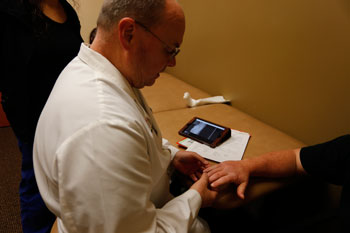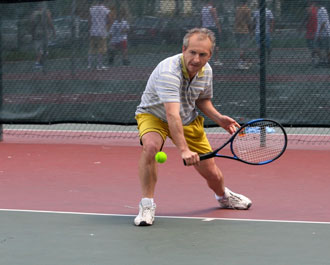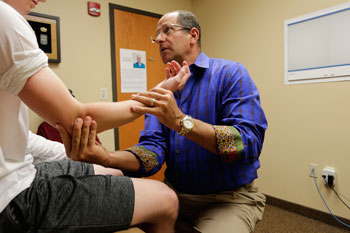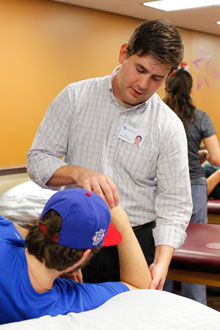
One of the only physical liabilities of having an office job is a hand injury in the form of carpal tunnel. Hands, arms and shoulders can also be hurt from sports injuries, arthritis, congenital deformities, and repetitive stress. The most common types of injuries are:
- Fractures and sprains
- Carpal tunnel syndrome
- Tendonitis
- Arthritis
- Nerve and tendon injuries or lacerations
- Rotator cuff tear
- Shoulder pain and instability
- Ganglion cysts
- Tennis elbow, Overuse injuries of the elbow
Dislocated Shoulder
If you have a dislocated shoulder, it can either be partially dislocated or fully dislocated. This can happen from falling or from contact sports like rugby or football. A hard hit pulls the arm out of the shoulder socket. It will swell up, become numb and weak, and bruise. A doctor will pop it back into place and then follow up orthopaedic care will be necessary until it regains stability.
Tennis Elbow (Golfer's Elbow)

Usually caused by overuse but sometimes a sudden impact, tennis elbow is a result of tiny, painful tears in the ligaments, and muscles around the elbow. The pain can radiate down the arm and is usually located on the outside of the elbow bone called the epicondyle. In the case of golfer's elbow, the pain is on the inside of the epicondyle. Usually those who experience this type of pain should avoid doing the activity that caused the pain (not just tennis, it can also be gardening, painting or any activity that causes repetitive stress on the arm). Continuing to perform an activity that incited the pain can cause pain to become worse and in some the cases, the elbow will become inflamed. Time is the best remedy to allow the tears to heal in the early stages. Anti-inflammatory medications like Advil can also be used as it helps to not only alleviate the pain, but also to reduce swelling in the arm. If pain persists, you may want to visit the doctor. Your doctor will be able to put you on a plan to help the pain go away and can offer strengthening exercises to help you get better.
For many tennis players, tennis elbow can be aggravating. Just grasping and squeezing the handle of the racquet can send an electric shock of pain up the arm. Worse, the treatment options traditionally have been to lay off tennis, wait for the tendons to settle down, and restrengthen them through a slow rehab process. If non-surgical options failed, even the traditional surgical options were also somewhat major.
Thankfully, there is a new option for those with tennis elbow. Our upper extremity specialists now have a new advance that holds great promise for quick recovery from tennis elbow syndrome.

Tennis Elbow (lateral epicondylitis) is a common problem and not just in athletes. This condition results in pain centered about the outside of the elbow during firm grasping and frequently radiates down toward the wrist. The theory is that tennis elbow is caused by the instability of the tendons in the elbow, and their inability to recover from overuse. Why these tendons fail to repair themselves with rest is believed to be from poor circulation in the tendons where they attach to the bone. This condition affects tennis players, carpenters, golfers, gardeners and almost anyone who must repeatedly firmly grasp athletic equipment or tools.
Traditional treatments have employed stretching, compressive straps, physical therapy, ice, rest or activity modifications, along with anti-inflammatories like Advil or Nuprin.
When these treatment options fail, physicians then resort to injections of steroids into the elbow area which can be helpful in many cases to speed relief and healing. However, what is interesting is that unlike most medication injections, pain relief may actually come from the needle puncture to the tendons rather than the medication injected.
In the past when injections failed to resolve the problem, surgical intervention was considered. The traditional procedure involves peeling the tendon insertion off the bone of the lateral elbow and penetrating the hard center surface of the bone. When the tendon is re-attached there is usually enough fibrous healing to cure the problem. Typically, surgery is considered an option when all other nonsurgical treatments have failed.
Elbow Bursitis
Why do cars have bumpers on them? We all know it is to keep the main part of the car from harm. Between the skin and our elbow bone our bodies have "bumpers" that allow help prevent injuries to the elbow joint. The bumper is known as the bursa, small sacs of fluid that reside between the skin and the bone to allow easy, pain-free movement.
You may have noticed that when you rest your elbow on the table for too long of a time period it starts to hurt and may sport a reddish tint. This is your bursa telling you to lay off the elbows for a while. If you were to continue to rest weight on the elbows, they would inflame, and hurt. When irritated, it is a good idea to stop the activity that is causing the pain, take an anti-inflammatory medication such as Advil, put ice on the elbow, and elevate to reduce blood flow. If the elbow hurts a lot of the time, you should have a doctor look at them. He or she may be able to drain the bursa or inject corticoseroid into the arm to relieve pain. In some cases, the bursa may need to be removed.
Rotator Cuff Tears

As the most flexible joint in the body, the shoulder is capable of performing a wide range of activities. However, with this incredible range of motion, it is at high risk for overuse and the joint is prone to tearing over time causing a great deal of pain. Since a rotator cuff injury stems from a ligament or muscle tear in the shoulder, improper posture and lifting, falling down, or repetitive strain on the shoulder can all lead to rotator cuff tears.
A rotator cuff tear is particularly common among those over the age of 40 since this is when collagen does not produce itself as fast in the body and calcium deposits settle in the shoulder joint though it can affect people of any age.
Treating a rotator cuff nonsurgically may be appropriate depending on the severity of the injury. In many cases, the best thing to do is administer RICE (rest from the activity causing the pain, apply ice to the injured area, compress the injured area, and elevate the injured area above the heart to limit blood flow).
When it hurts to sleep on the affected shoulder, lifting the arms is uncomfortable, the pain resides in the dominant arm or the affected shoulder continues to make noises, it is a good idea have a doctor give you an examination.
[Top]
